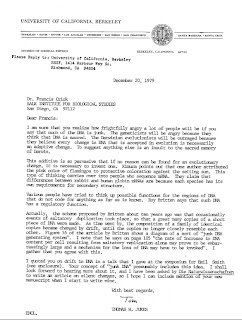Dan Graur discovered that the term "junk DNA" was commonly used in the 1960's—long before Susumu Ohno used "junk" in the title of his 1972 paper. This makes a lot of sense. Apparently the term was quite commonly used in Cambridge by people like Francis Crick and Sydney Brenner. (Perhaps you've heard of them?)
Graur found a 1963 paper that refers to "junk" DNA. This is the earliest known refencee to junk in the scientific literature. Read about his sleuthing at: The Origin of Junk DNA: A Historical Whodunnit.
Meanwhile, a person named "ShadiZl" commented on one my posts and pointed me to a letter from Thomas Jukes to Francis Crick in 1979. Jukes, you might recall, was no Darwinian. He was a proponent of Neutral Theory and random genetic drift. The letter is archived on the National Library of Medicine (USE) site under a section devoted to The Francis Crick Papers: Letter from Thomas H. Jukes to Francis Crick.
The letter is interesting because it reveals how casually the "insiders" talked about junk DNA and about the adaptationist misconception even as far back as 1979. This was when Gould and Lewontin published the "spandrels" paper. It also reveals how misguided the creationists are when it comes to the history of junk DNA. They still think that it was "Darwinists" who "predicted" junk DNA based on their view of natural selection. (Do not read this letter if you are irony-deficient. It will only confuse you.)December 20, 1979
Dear Francis:
I am sure that you realize how frightfully angry a lot of people will be if you say that much of the DNA is junk. The geneticists will be angry because they think that DNA is sacred. The Darwinian evolutionists will be outraged because they believe every change in DNA that is accepted in evolution is necessarily an adaptive change. To suggest anything else is an insult to the sacred memory of Darwin.
This additive is so pervasive that if no reason can be found for an evolutionary change, it is necessary to invent one. Kimura points out that one author attributed the pink color of flamingos to protective coloration against the setting sun. This type of thinking carries over into people who sequence mRNA. They claim that differences between rabbit and human globin mRNAs are because each species has its own requirements for secondary structure.
Various people have tried to think up possible functions for the regions of DNA that do not code for anything as far as is known. Roy Britten says that such DNA has a regulatory function.
Actually, the scheme proposed by Britten about ten years ago was that occasionally events of saltatory duplication, took place, so that a great many copies of a short piece of DNA were made. As time went by, the composition of a family of identical copies became changed by drift, until the copies no longer closely resemble each other. Figure 55 of the article by Britten shows a diagram of a sort of "junk DNA generating system". I note that he says on page 105 "the rate of increase in DNA content per cell resulting from saltatory replication alone may prove to be embarrassingly large and a mechanism for the loss of DNA may have to be invoked". I gather that you agree with this.
I quoted you on drift in DNA in a talk that I gave at the symposium for Emil Smith (see enclosure). Your concept of "junk DNA" presumably includes this idea. I shall look forward to hearing more about it, and I have been asked by Die Naturwissenschaften to write an article on silent changes, so I hope I can include mention of your new manuscript when I start to write mine.
With best regards,
Thomas H. Jukes
Resep Martabak Manis
-
Resep Martabak Manis - Kali kami akan memberikan resep terbaru tentang cara
membuat martabak manis, resep martabak manis ini sangat sederhana sehingga
muda...
11 years ago




.JPG)




.jpg)

dbl.jpg)
